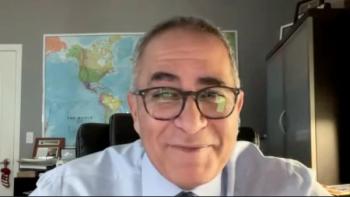
Oncology NEWS International
- Oncology NEWS International Vol 9 No 2
- Volume 9
- Issue 2
Durable Complete Remissions Possible ‘Prelude to Cure’ in Multiple Myeloma
LITTLE ROCK-Durable complete remissions “as a prelude to cure” can be obtained in more than half of good-risk multiple myeloma patients who are optimally treated. This conclusion was based on findings from 1,000 consecutive multiple myeloma patients enrolled from 1988 to 1998 in tandem melphalan-based high-dose therapy (HDT) trials with autologous hematopoetic stem cell support. The study was conducted by Bart Barlogie, MD, and colleagues from the Myeloma and Transplantation Research Center, University of Arkansas for Medicine Sciences, and reported at the ASH meeting.
LITTLE ROCKDurable complete remissions as a prelude to cure can be obtained in more than half of good-risk multiple myeloma patients who are optimally treated. This conclusion was based on findings from 1,000 consecutive multiple myeloma patients enrolled from 1988 to 1998 in tandem melphalan-based high-dose therapy (HDT) trials with autologous hematopoetic stem cell support. The study was conducted by Bart Barlogie, MD, and colleagues from the Myeloma and Transplantation Research Center, University of Arkansas for Medicine Sciences, and reported at the ASH meeting.
Treatment-related mortality was 7% overall following two high-dose treatment cycles. Complete remissions, achieved by 44%, lasted a median of 2.4 years. At 5 years, projected event-free survival (EFS) was 25% and overall survival (OS) was 40%.
In the best-risk group, the 5-year continuous complete remission rate was 52%. This high response was achieved among the 112 complete remission patients without chromosome 13 abnormalities and with beta-2 microglobulin (B2M) 2.5 mg/L or less, C-reactive protein 4 mg/L or less, and pre-HDT standard therapy of 12 months or less, Dr. Barlogie reported.
Chromosome 13 Abnormalities
Of all 390 complete remission patients without chromosome 13 abnormalities, 35% had 5-year continuous complete remissions. Of 54 patients who did have a chromosome 13 abnormality, none had a 5-year continuous response.
Chromosome 13 abnormality, which was seen in 16% of the patients overall, reduced the 5-year EFS from 20% to 0% overall, and reduced OS from 44% to 16% (both P < .001). A second high dose therapy cycle applied within 6 months extended survival, the study found.
All patients received melphalan (Alkeran) 200 mg/m² for the first HDT cycle, and 76% received a second HDT cycle within 12 months, mostly with melphalan 200 mg/m² but also with melphalan 140 mg/m² plus total body irradiation or other chemotherapy. Patient characteristics included a median age of 53 (range 14 to 82) and resistance to prior standard therapy in 38%.
Predictors of complete remission were sensitivity to prior high-dose therapy, absence of a chromosome 13 deletion, and less than 12 months of prior therapy. IgA isotype was associated with a good initial response, but poorer final outcome, Dr. Barlogie observed.
Independent Predictors
A multivariate analysis revealed several independent predictors of outcome, the most consistently important variable being absence of a chromosome 13 abnormality. Patients without this cytogenetic feature had significantly better survival (P < .0001 for both EFS and OS). Other factors improving both EFS and OS were low pre-HDT B2M and C-reactive protein levels, standard therapy 12 months or less, disease sensitivity, and absence of IGA isotype.
At 5 years, there were no complete sustained remissions for patients who had a chromosome 13 deletion, and few of these patients remained event-free. Among patients with no deletions of chromosome 13, continuous complete remissions were sustained in 42%.
Deletion of chromosome 13 identified a high-risk entity within each of the three dominant standard prognostic factorsB2M, C-reactive protein, and prior standard therapybut did not affect the influence of having a second high-dose cycle. An analysis at 6 months of patients who had been given a second high-dose cycle found that having a second cycle within 6 months of the first favorably impacted EFS and OS, regardless of the presence or absence of chromosome 13 deletion. But it is best to take chromosome 13 status into consideration in timing the second cycle, the study revealed.
Giving Second Cycle
In the absence of chromosome 13 deletion, one can take more time before you give the second cycle. But in the presence of chromosome 13 deletion, the second cycle has to be given very soon [for best effect]. This probably relates to a much greater proliferative activity in chromosome 13 deletion myeloma, for which our group and others have additional data, he noted.
I conclude that durable complete remissions can be achieved in multiple myeloma, especially in patients who do not exhibit chromosome 13 deletion who are treated with what I consider the most effective therapy, that is, high-dose melphalan-based therapy and the administration of a second cycle of therapy, Dr. Barlogie concluded.
Articles in this issue
almost 26 years ago
Neoadjuvant Docetaxel Increases Response Rate in Large Breast Tumorsalmost 26 years ago
Faslodex, a Pure Antiestrogen, Shows Antitumor Activityalmost 26 years ago
Consider Node Dissection, Adjuvant Therapy in Elderly Breast Cancer Patientsalmost 26 years ago
Tumor-Associated Proteases Predict Outcome in Node-Negative Patientsalmost 26 years ago
Herceptin Plus Vinorelbine a Promising Combination in Advanced Breast Canceralmost 26 years ago
Small Risk of Breast Cancer Death After Invasive Recurrence in DCIS Patientsalmost 26 years ago
Paclitaxel/Herceptin Effective in Metastatic Breast Canceralmost 26 years ago
Conservative Surgery Alone Not Sufficient to Prevent RecurrenceNewsletter
Stay up to date on recent advances in the multidisciplinary approach to cancer.


![“[This approval] will be a quite dramatic change in our philosophy and practice in multiple myeloma," according to Joseph Mikhael, MD, MEd, FRCPC, FACP, FASCO.](https://cdn.sanity.io/images/0vv8moc6/cancernetwork/3cab3ada4c023b68c118240a512e31d72a7f931b-1200x628.png?w=350&fit=crop&auto=format)

















































































